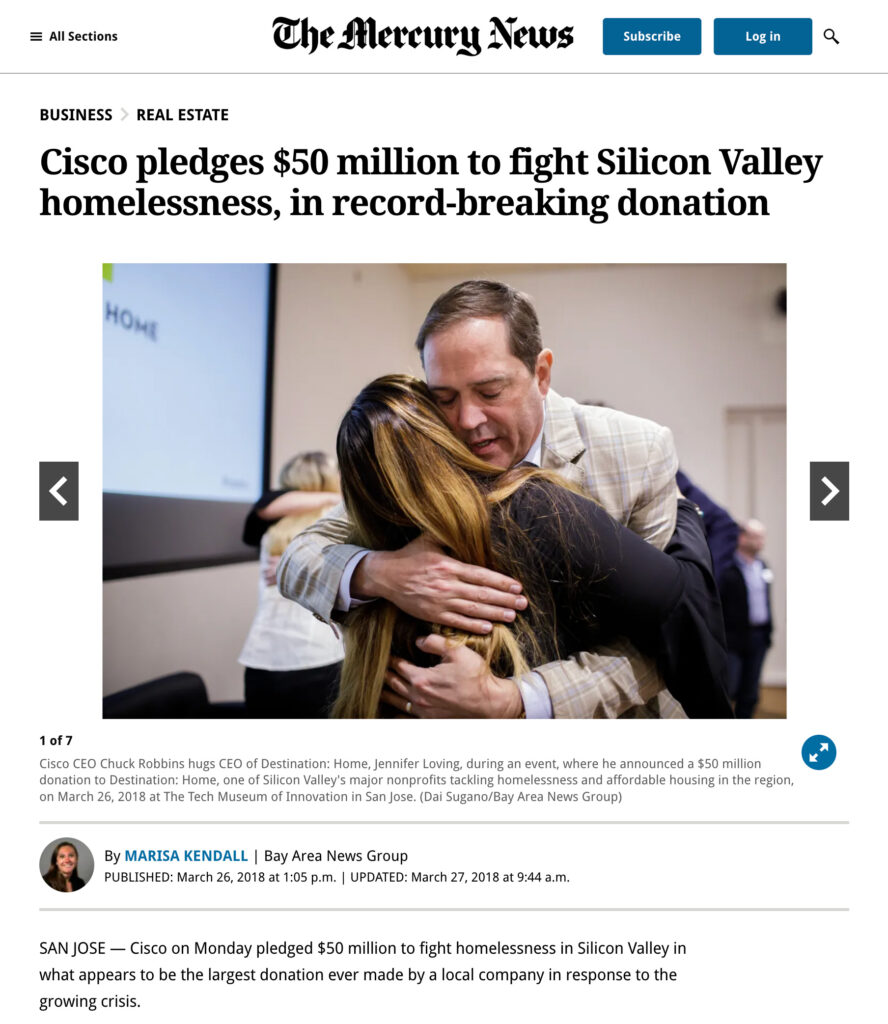Securing New Sources of Funding
A lack of dedicated and sustainable funding has always been one of the largest barriers to efforts to end homelessness. So throughout its journey, this coalition has worked hard to secure funding from a variety of sources. This remains a major area of need, however this coalition’s success securing key sources of public and private funding has been instrumental to its ability piloting new strategies, scaling promising initiatives and sustaining its work over time.
County of Santa Clara Develops a Groundbreaking Housing Bond
In February 2015, the Santa Clara County Board of Supervisors formed a housing task force, which included representatives from the public, private, and nonprofit sectors, that met on a monthly basis for nine months and released its final report in December 2015. One of its primary findings was that new sources of funding were needed for new housing development – including a Regional Supportive Housing Services and Development Fund, which the Board of Supervisors adopted with $64 million in annual allocations for developing new housing and investing in supportive services. The task force also recommended that cities consider initiating ballot measures that would earmark funding for affordable housingSubsidized housing where rents are set at a below-market rate based on the tenant’s income. There are many different types of affordable housing — units are typically designated based on a tenant’s income level (i.e., low-income vs. extremely low-income) and certain types of affordable housing may also be reserved for a specific demographic (i.e., seniors or veterans). Deeply affordable housing refers to developments or units where rents are kept particularly low and are intended to serve the lowest-income residents in the community.
Armed with the task force’s recommendations, and the findings of the Home Not Found report, the coalition began the hard work of raising funding to support its work.
Recognizing that bold new investments were critical, leaders at the County of Santa Clara decided to go big. In 2016, the Board of Supervisors placed a $950 million affordable housing bond measure on the ballot (known as Measure A) – with $700 million of that set aside for extremely low-income housing, permanent supportive housing and rapid rehousing. For decades, these types of housing never got built — they were simply too expensive without substantial incentives – but after the “Home Not Found” study showed that status quo approaches were not cost-effective, momentum grew to secure significant funding to develop deeply affordable housing.
The basic theory that everybody deserves a safe and healthy place to lay their head, we were able to convey that through lots and lots of stories. And for a moment in our community, people weren’t blaming folks for being homeless.
Cindy Chavez, Supervisor for District 2, Santa Clara County
Public polling in early 2016 showed just under the two-thirds support needed to pass the ballot initiative, known as Measure A, with less than 10% of voters still undecided. Members of the coalition worked in partnership with other elected officials, affordable housing advocates, and community organizations to champion Measure A. Supervisor Cindy Chavez- who was a key architect of the measure – campaigned heavily for its passage, and the South Bay Labor Council was hired to run the grassroots campaign to convince residents to vote yes. Through op-eds, key endorsements, and “get out the vote” campaigns, advocates secured Measure A’s passage with just over 67% of ballots in favor.
Since its passage, the Measure A Affordable Housing Bond has been a critical catalyst for a surge in production of deeply affordable housing development in Santa Clara County. In fact, this robust, dedicated pool of money has been used to develop or renovate over 5,800 affordable apartments across 56 different developments in 10 cities.


The Private Sector Steps Up

Even with nearly a billion dollars earmarked for affordable housing development, there was still a need for flexible capital. With residential land scarce and competition coming from the private real estate development sector, there was a need for money that could be deployed quickly and nimbly in order to acquire land and fund predevelopment activities ahead of more rigid public funding. So, Destination: Home began exploring opportunities to more deeply engage the private sector and raise private funding that could help fill this critical need.
At the same time, Chuck Robbins, CEO of Cisco – a networking technology company headquartered in San Jose – had begun talking to members of the coalition about the homelessness challenge in the community. Tech companies are major players in the landscape of Silicon Valley, but also contribute to the rapidly rising cost of living in the region, which disproportionately impacts the poorest residents first. And Robbins was interested in how he could play a meaningful role in addressing this important issue.
In 2018, Cisco made a $50 million grant to Destination: Home to support the coalition’s efforts to end homelessness – at the time, the largest corporate philanthropic contribution ever made to address homelessness in the U.S. and a key catalyst in the coalition’s efforts to raise more private funding in support of this important work.
There doesn’t always have to be a direct line to your business, if it affects the community in which you operate, where you work, and where your employees live. We want those communities to be thriving.
Erin Connor, Director of Crisis Response, Cisco
Thanks to Cisco’s foundational gift, a subsequent $50 million contribution from Apple, and the support of dozens of other private sector funders, Destination: Home alone has raised and deployed roughly $300 million in flexible, private funding in support of many key strategies of the Community Plan to End Homelessness, including the production of more deeply affordable housing.
In addition to financial contributions, private sector partners have also used their power and networks to connect the coalition to other major donors. Some companies have even provided in-kind contributions, including professional development training, a corporate communications platform, and government relations support. This philanthropic power and resource sharing has helped catapult the coalition’s ability to reshape the affordable housing ecosystem in Santa Clara County.
City of San Jose’s Measure E Transfer Tax
As the largest city in the county, the City of San Jose realized it would need more resources to carry forward efforts to address homelessness as well. The statewide dissolution of redevelopment agencies in 2012 had eliminated one of the only robust sources of affordable housing available to the City of San Jose, and ongoing budget challenges left little available in the General Fund to build more critically-needed deeply affordable housing.
So, in late 2019, the San Jose City Council voted to place a measure on the ballot to increase the city’s transfer tax on real estate transactions over $2 million. While the measure (which would be designated Measure E) was placed on the ballot as a general tax, the City Council concurrently adopted a spending plan allocating the vast majority of funding to new affordable housing production. This plan also prioritized the needs of San Jose’s most in need residents, with more than half of the funding dedicated to either extremely low income / permanent supportive housingA type of housing unit or program that combines affordable housing with support services (for example, mental health, employment, or peer support services) that has proven successful in helping homeless individuals become and stay housed. Supportive housing programs can come in many forms, including long-term programs (i.e., Permanent Supportive Housing) and shorter-term support (i.e., Rapid Rehousing). development or homelessness prevention programs.

Mayor Sam Liccardo and SV@Home brought together a wide array of partners (including many in this coalition) to mount a robust campaign in support of Measure E – which ultimately was passed by San Jose voters in March 2020, providing another key source of funding to support the community’s efforts to end homelessness. In fact, since its adoption, the Measure E transfer tax has generated approximately $50 million annually and served as a critical source of funding to expand affordable housing production, homelessness prevention and other key programs and services for addressing homelessness
